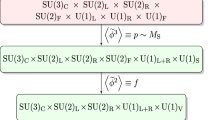Abstract
In minimal supergravity (mSUGRA) or CMSSM, one of the main co-annihilating partners of the neutralino is the lightest stau, \(\tilde{\tau}_1\). In the presence of flavour violation in the right-handed sector, the co-annihilating partner would be a flavour mixed state. The flavour effect is two-fold: (a) It changes the mass of \(\tilde{\tau}_{1}\), thus modifying the parameter space of the co-annihilation and (b) flavour violating scatterings could now contribute to the cross-sections in the early Universe. In fact, it is shown that for large enough δ~0.2, these processes would constitute the dominant channels in co-annihilation regions. The amount of flavour mixing permissible is constrained by flavour violating τ→μ or τ→e processes. For ΔRR mass insertions, the constraints from flavour violation are not strong enough in some regions of the parameter space due to partial cancellations in the amplitudes. In mSUGRA, the regions with cancelations within LFV amplitudes do not overlap with the regions of co-annihilations. In non-universal Higgs model (NUHM), however, these regions do overlap leading to significant flavoured co-annihilations. At the LHC and other colliders, these regions can constitute for interesting signals.

Similar content being viewed by others
References
G Jungman, M Kamionkowski and K Griest, Phys. Rep. 267, 195 (1996), hep-ph/9506380
P H Chankowski, J R Ellis, K A Olive and S Pokorski, Phys. Lett. B452, 28 (1999), hep-ph/9811284
D Larson, J Dunkley, G Hinshaw et al, arXiv:1001.4635 [astro-ph.CO]
H Baer, C Balazs, A Belyaev, T Krupovnickas and X Tata, J. High Energy Phys. 0306, 054 (2003), arXiv:hep-ph/0304303
D Chowdhury, R Garani and S K Vempati, J. High Energy Phys. 1206, 014 (2012), arXiv:1104.4467 [hep-ph]
J Hisano, T Moroi, K Tobe, M Yamaguchi and T Yanagida, Phys. Lett. B357, 579 (1995), hep-ph/9501407
I Masina and C A Savoy, Nucl. Phys. B661, 365 (2003), hep-ph/0211283
Having A 0 ≠ 0 and very large δ RR (∼0.9) might give rise to a non-zero but tiny overlap at a very large M 1/2
Author information
Authors and Affiliations
Corresponding author
Rights and permissions
About this article
Cite this article
CHOWDHURY, D., GARANI, R. & VEMPATI, S.K. Flavoured co-annihilation. Pramana - J Phys 79, 849–852 (2012). https://doi.org/10.1007/s12043-012-0388-0
Published:
Issue Date:
DOI: https://doi.org/10.1007/s12043-012-0388-0



